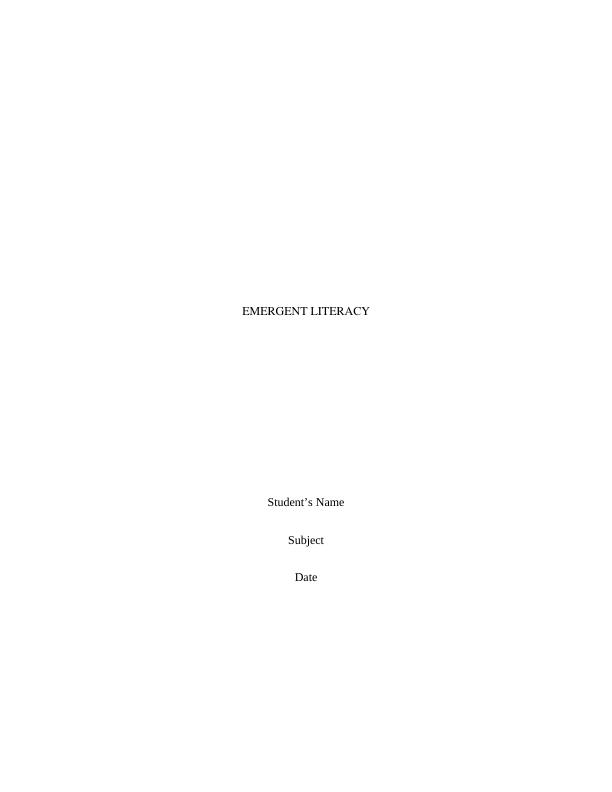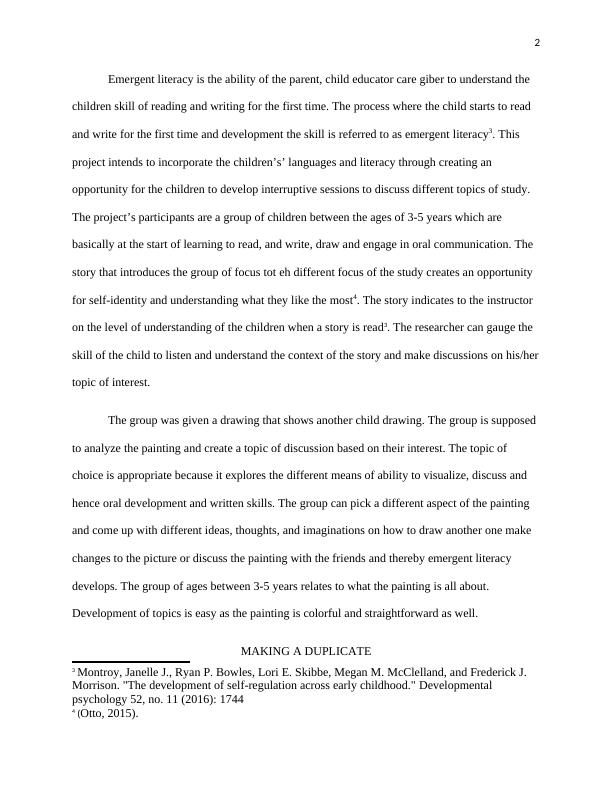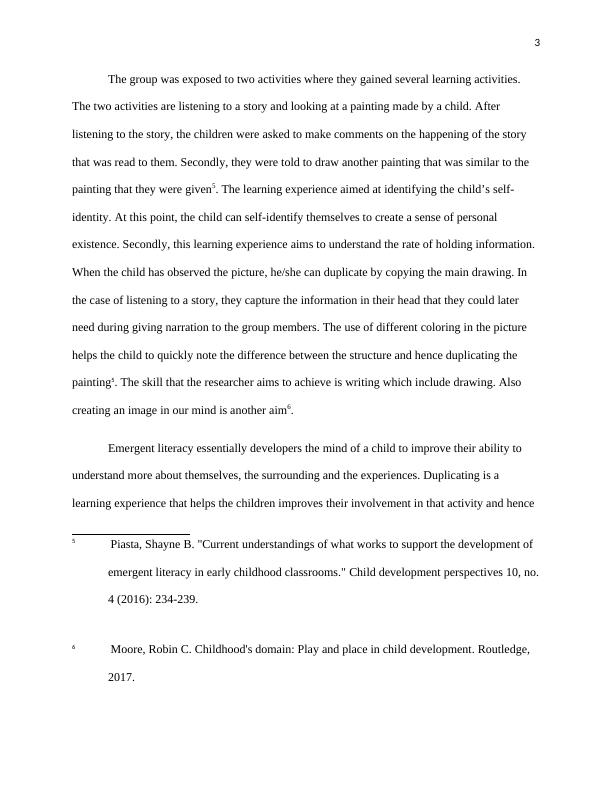Emergent Literacy: A Study on the Development of Reading, Writing, and Drawing Skills in Children
Added on 2023-06-04
12 Pages2735 Words198 Views
EMERGENT LITERACY
Student’s Name
Subject
Date
Student’s Name
Subject
Date

1
INTRODUCTION
The project will try to find out the emergent literacy of three children named Mark
Sophie and John. The three are aged four, three and five respectively, and the instructor observes
their behavior while they are interacting. Some sets of learning activities are provided to the
group which will then be used to gauge the different level of emergent literacy among the young
children1. The study aims to demonstrate the ability and the skill of the child to learn, read, write
and draw for the first time. The influences that the instructor has on the development of the
emergent literacy is analyzed and especially in giving direction to the children.
The group is provided with a painting done by another child of four individuals likely to
be a member so of a family. The group is mandated to view the painting and make discussion
pending on their topic of interest which is related to the topic2. Basing on the Early Years of
Learning Framework (EYLF) outcomes, the researcher aims to determine children’s emergent
literacy relating t these outcomes such as self-identity, wellbeing and effective communication.
The study is therefore designed to increase the developmental assistance to the emergent literacy
among the children between the ages of 3-5 years.
EMERGENT LITERACY
1 Otto, Beverly. Literacy development in early childhood: Reflective teaching for birth to
age eight. Waveland Press, 2015.
2 Flewitt, Rosie, David Messer, and Natalia Kucirkova. "New directions for early literacy
in a digital age: The iPad." Journal of Early Childhood Literacy 15, no. 3 (2015): 289-
310.
INTRODUCTION
The project will try to find out the emergent literacy of three children named Mark
Sophie and John. The three are aged four, three and five respectively, and the instructor observes
their behavior while they are interacting. Some sets of learning activities are provided to the
group which will then be used to gauge the different level of emergent literacy among the young
children1. The study aims to demonstrate the ability and the skill of the child to learn, read, write
and draw for the first time. The influences that the instructor has on the development of the
emergent literacy is analyzed and especially in giving direction to the children.
The group is provided with a painting done by another child of four individuals likely to
be a member so of a family. The group is mandated to view the painting and make discussion
pending on their topic of interest which is related to the topic2. Basing on the Early Years of
Learning Framework (EYLF) outcomes, the researcher aims to determine children’s emergent
literacy relating t these outcomes such as self-identity, wellbeing and effective communication.
The study is therefore designed to increase the developmental assistance to the emergent literacy
among the children between the ages of 3-5 years.
EMERGENT LITERACY
1 Otto, Beverly. Literacy development in early childhood: Reflective teaching for birth to
age eight. Waveland Press, 2015.
2 Flewitt, Rosie, David Messer, and Natalia Kucirkova. "New directions for early literacy
in a digital age: The iPad." Journal of Early Childhood Literacy 15, no. 3 (2015): 289-
310.

2
Emergent literacy is the ability of the parent, child educator care giber to understand the
children skill of reading and writing for the first time. The process where the child starts to read
and write for the first time and development the skill is referred to as emergent literacy3. This
project intends to incorporate the children’s’ languages and literacy through creating an
opportunity for the children to develop interruptive sessions to discuss different topics of study.
The project’s participants are a group of children between the ages of 3-5 years which are
basically at the start of learning to read, and write, draw and engage in oral communication. The
story that introduces the group of focus tot eh different focus of the study creates an opportunity
for self-identity and understanding what they like the most4. The story indicates to the instructor
on the level of understanding of the children when a story is read3. The researcher can gauge the
skill of the child to listen and understand the context of the story and make discussions on his/her
topic of interest.
The group was given a drawing that shows another child drawing. The group is supposed
to analyze the painting and create a topic of discussion based on their interest. The topic of
choice is appropriate because it explores the different means of ability to visualize, discuss and
hence oral development and written skills. The group can pick a different aspect of the painting
and come up with different ideas, thoughts, and imaginations on how to draw another one make
changes to the picture or discuss the painting with the friends and thereby emergent literacy
develops. The group of ages between 3-5 years relates to what the painting is all about.
Development of topics is easy as the painting is colorful and straightforward as well.
MAKING A DUPLICATE
3 Montroy, Janelle J., Ryan P. Bowles, Lori E. Skibbe, Megan M. McClelland, and Frederick J.
Morrison. "The development of self-regulation across early childhood." Developmental
psychology 52, no. 11 (2016): 1744
4 (Otto, 2015).
Emergent literacy is the ability of the parent, child educator care giber to understand the
children skill of reading and writing for the first time. The process where the child starts to read
and write for the first time and development the skill is referred to as emergent literacy3. This
project intends to incorporate the children’s’ languages and literacy through creating an
opportunity for the children to develop interruptive sessions to discuss different topics of study.
The project’s participants are a group of children between the ages of 3-5 years which are
basically at the start of learning to read, and write, draw and engage in oral communication. The
story that introduces the group of focus tot eh different focus of the study creates an opportunity
for self-identity and understanding what they like the most4. The story indicates to the instructor
on the level of understanding of the children when a story is read3. The researcher can gauge the
skill of the child to listen and understand the context of the story and make discussions on his/her
topic of interest.
The group was given a drawing that shows another child drawing. The group is supposed
to analyze the painting and create a topic of discussion based on their interest. The topic of
choice is appropriate because it explores the different means of ability to visualize, discuss and
hence oral development and written skills. The group can pick a different aspect of the painting
and come up with different ideas, thoughts, and imaginations on how to draw another one make
changes to the picture or discuss the painting with the friends and thereby emergent literacy
develops. The group of ages between 3-5 years relates to what the painting is all about.
Development of topics is easy as the painting is colorful and straightforward as well.
MAKING A DUPLICATE
3 Montroy, Janelle J., Ryan P. Bowles, Lori E. Skibbe, Megan M. McClelland, and Frederick J.
Morrison. "The development of self-regulation across early childhood." Developmental
psychology 52, no. 11 (2016): 1744
4 (Otto, 2015).

3
The group was exposed to two activities where they gained several learning activities.
The two activities are listening to a story and looking at a painting made by a child. After
listening to the story, the children were asked to make comments on the happening of the story
that was read to them. Secondly, they were told to draw another painting that was similar to the
painting that they were given5. The learning experience aimed at identifying the child’s self-
identity. At this point, the child can self-identify themselves to create a sense of personal
existence. Secondly, this learning experience aims to understand the rate of holding information.
When the child has observed the picture, he/she can duplicate by copying the main drawing. In
the case of listening to a story, they capture the information in their head that they could later
need during giving narration to the group members. The use of different coloring in the picture
helps the child to quickly note the difference between the structure and hence duplicating the
painting5. The skill that the researcher aims to achieve is writing which include drawing. Also
creating an image in our mind is another aim6.
Emergent literacy essentially developers the mind of a child to improve their ability to
understand more about themselves, the surrounding and the experiences. Duplicating is a
learning experience that helps the children improves their involvement in that activity and hence
5 Piasta, Shayne B. "Current understandings of what works to support the development of
emergent literacy in early childhood classrooms." Child development perspectives 10, no.
4 (2016): 234-239.
6 Moore, Robin C. Childhood's domain: Play and place in child development. Routledge,
2017.
The group was exposed to two activities where they gained several learning activities.
The two activities are listening to a story and looking at a painting made by a child. After
listening to the story, the children were asked to make comments on the happening of the story
that was read to them. Secondly, they were told to draw another painting that was similar to the
painting that they were given5. The learning experience aimed at identifying the child’s self-
identity. At this point, the child can self-identify themselves to create a sense of personal
existence. Secondly, this learning experience aims to understand the rate of holding information.
When the child has observed the picture, he/she can duplicate by copying the main drawing. In
the case of listening to a story, they capture the information in their head that they could later
need during giving narration to the group members. The use of different coloring in the picture
helps the child to quickly note the difference between the structure and hence duplicating the
painting5. The skill that the researcher aims to achieve is writing which include drawing. Also
creating an image in our mind is another aim6.
Emergent literacy essentially developers the mind of a child to improve their ability to
understand more about themselves, the surrounding and the experiences. Duplicating is a
learning experience that helps the children improves their involvement in that activity and hence
5 Piasta, Shayne B. "Current understandings of what works to support the development of
emergent literacy in early childhood classrooms." Child development perspectives 10, no.
4 (2016): 234-239.
6 Moore, Robin C. Childhood's domain: Play and place in child development. Routledge,
2017.

End of preview
Want to access all the pages? Upload your documents or become a member.
Related Documents
Understanding Language and Literacy Assignment 2022lg...
|12
|2882
|21
Enhancing Literacy and Language Development in Preschool Childrenlg...
|9
|2550
|239
EDU10002 Project 3: Learning Activity Planlg...
|5
|1894
|220
Developing Early Literacy: Assessment and Teachinglg...
|9
|1857
|394
Language and Literacies in Early Childhoodlg...
|12
|2855
|296
Developing a Literacy Resource Kit for Early Childrenlg...
|9
|2468
|274
